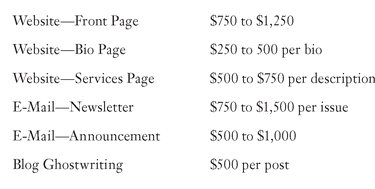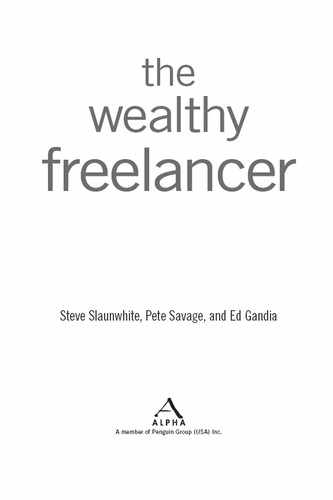Create a Fee Schedule
Your dentist informs you that you have a cavity that needs to be filled. You ask, “How much is that going to cost?” She replies, “Hmm, let’s see, not sure, … well, I’ll get back to you with a quote.” That hardly instills confidence in the person who’s about to drill a hole in your tooth! The good news is, a dentist is likely not going to reply in that way. Why? Because she probably has a fee schedule detailing her prices for a broad range of procedures. She’s not going to um and ah. Instead, she’s going to state with matter-of-fact confidence, “The fee is $192.”
That’s just one of the many benefits of developing a fee schedule. It inspires confidence and, as a result, prospective clients are more likely to say yes to your price.
Fee Schedules Up Close
A fee schedule is simply a document that lists your services and corresponding fees. Here’s an excerpt from the fee schedule of a freelance web writer:

Notice that this freelancer quotes a fee range rather than a fixed price. This gives her the wiggle room she needs to consider individual client and project requirements. After all, not every website front page is the same.
A fee schedule makes the entire process of determining a price and quoting a job a lot less stressful and time-consuming. I know some freelancers who agonize for hours preparing a quotation. I get frantic calls all the time from colleagues in my field (copywriting) asking, “Steve, I have to quote a media kit and I don’t have a clue what price to charge! Help!” When you have a fee schedule, that’s not a problem.
A fee schedule also helps deter low-paying clients. Unfortunately, there are plenty of them out there, waiting to toss you crumbs in exchange for your talents and knowledge. Unless you need to grab some of that work to pay the bills—we’ve all been there—you’ll want to discourage these types of clients before they waste too much of your time. Showing them your fee schedule is a great way to do that. No wonder expensive restaurants post their menus outside their front doors!
But the most important benefit of having a fee schedule is that it enables you to quote a ballpark price right away. And as you’ll find out in the next section, this is key to winning more work.
Determining Your Prices
Perhaps the most challenging aspect of creating a fee schedule is working out what your fees are in the first place. This requires some research on your part. You have to find out what the going professional rates are for the services you offer.
Notice I said professional rates? Lots of designers charge $150 for a stationery design, but they’re firmly where you don’t want to be—in the bargain-basement category. Professional branding designers charge considerably more, and you have to know what those rates are so you can set your fees accordingly.
Depending on your experience in your particular freelance field, you may intuitively know what to charge for particular types of projects. But what if you don’t? Here are some tips for finding out:
Create your own price club. Over the years, I’ve built relationships with several colleagues I’m comfortable calling to ask for pricing information and advice. We call it our “price club.” I just pick up the phone and say, “Hey, Dianna. How much do you charge to write a press release?” You can set up the same arrangement with colleagues you know.
Freelance websites. Some freelance professionals post their fee schedules on their websites. Isn’t that convenient! Find some of these sites, and you’ll gain useful insights into pricing in your freelance field. Be careful, though: just because a freelancer posts his fee schedule online doesn’t necessarily mean those rates are reflective of what professionals should be charging. Christy Wagner, editor of this book, suggests that you review at least three such websites and then average the prices. I agree!
Professional associations. Many professional associations for writers, photographers, graphic designers, and so forth publish pricing guidelines. The American Society of Journalists and Authors, an association I belong to, provides its members with a schedule of going rates for a long list of writing projects.
Your prospects and clients. This is often your best source of pricing information. Here’s a tip: quote prospective clients a little higher than you normally do when your schedule is full and you don’t really need the work. It’s a great way to find the “price ceiling.”
You won’t create the perfect fee schedule overnight. It’s always going to be a work in progress. Expect to make adjustments as you gain experience with pricing and learn more about how much you can get for the types of projects you handle. If in doubt about what to charge for something, be daring and set your price a little higher than you think clients would be willing to pay. You might be pleasantly surprised when you quote that price and get the job!
Your Time and Talents May Be Worth More Than You Think
For many years, freelancer Debbie Charette charged clients $750 to write a case study (a product success story). Because she could write these fairly quickly, the job was profitable for her. However, when she got busy, she took a chance and quoted a few new prospects a higher rate: $1,250. Her new price was met with no resistance. Obviously, clients valued having these important marketing pieces done professionally and were more than willing to pay a higher fee. By taking a chance and raising her rates, she increased her project income by more than 65 percent!
..................Content has been hidden....................
You can't read the all page of ebook, please click here login for view all page.
